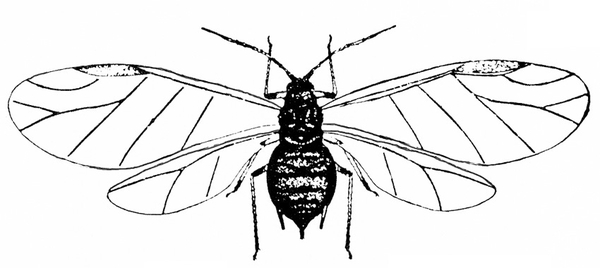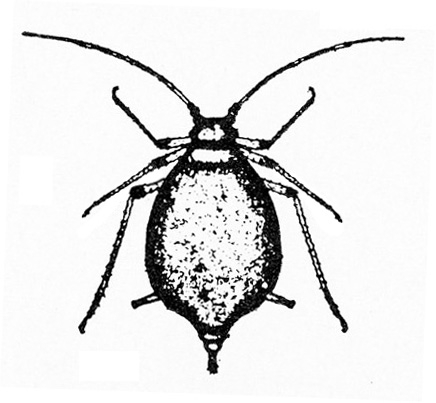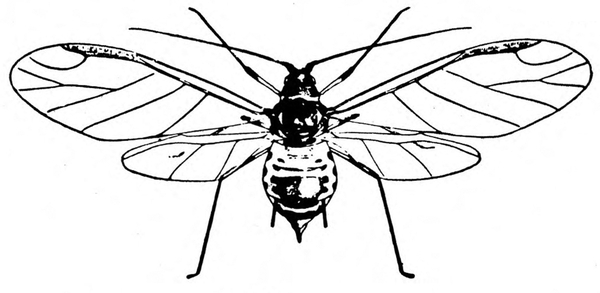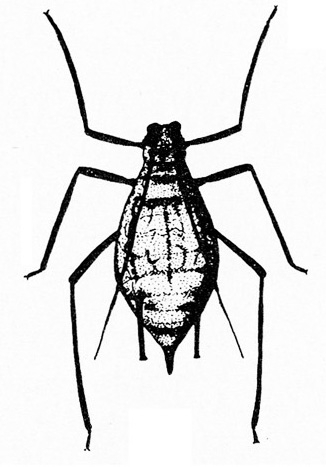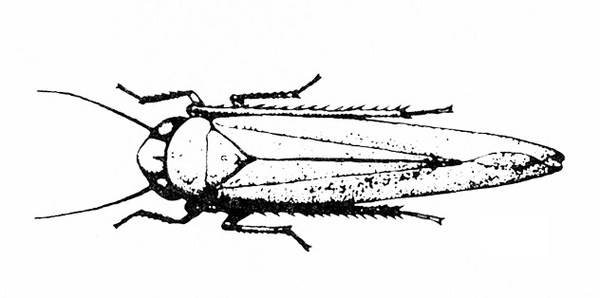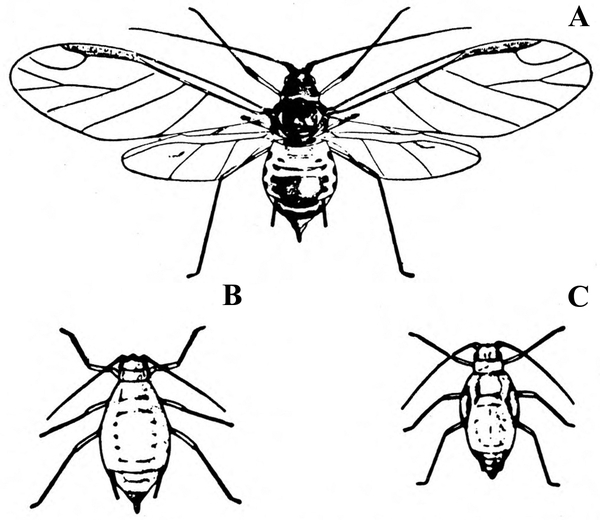Caterpillars that attack the fall crop are usually the most troublesome field pests of lettuce. In the greenhouse, aphid and cabbage looper infestations often cause problems. Cutworms, whiteflies, leafminers, and slugs are slightly less important greenhouse pests. Aphids cause additional problems by transmitting several viruses, including lettuce mosaic.
A. Caterpillars that sever or make holes in foliage
- Beet armyworm—A soft-bodied green or black caterpillar up to 1 3/16 inches long, the beet armyworm has three light-colored stripes running the length of the body, a black spot on each side on the second segment behind the head, three pairs of legs, and five pairs of prolegs (Figure 1). It damages buds and young leaves. (For more information about beet armyworms, see “Pests of Asparagus.”)
- Cabbage looper—Green with longitudinal white stripes, this caterpillar is up to 1 3/16 inches long, tapering toward the head. It has three pairs of legs near the head and three pairs of fleshy prolegs (Figure 2). Young larvae are found on undersides of leaves; mature larvae are found deep within the head. The insects consume tender leaf tissue, leaving most veins intact. (For more information about cabbage loopers, see “Pests of Crucifers.”)
- Cutworms—These fat, basically gray, brown, or black caterpillars are 1 5/8 to 2 inches long when fully grown, with three pairs of legs near the head and five pairs of fleshy prolegs (Figure 3). Cutworms are active at night—with young caterpillars climbing on leaves and older caterpillars severing leaf stalks. They hide during the day in soil burrows near the bases of plants. (For more information about cutworms, see “Pests of Asparagus.”)
- Imported cabbageworm—This velvety-looking, green caterpillar is up to 1 1/4 inches long. It has a yellow stripe down the back, a row of yellow spots down each side, three pairs of legs near the head, and five pairs of prolegs (Figure 4). It feeds deeper in the plant and is more likely to eat small veins than the cabbage looper. Affected leaves are wet, with greenish-brown excrement deep among the leaves. (For more information about imported cabbageworms, see “Pests of Crucifers.”)
B. Small (less than 3/16 inch long), piercing-sucking insects that extract sap and create discolored areas on foliage
- Aphids—These pale-green to dark, soft-bodied, pear-shaped insects have a pair of dark cornicles and a short "tail" (the cauda) protruding from the abdomen. The body is almost 3/8 inch long. They may be winged or wingless, though the wingless form is most common. Aphids feed in colonies, causing discoloration or mottling of foliage, often transmitting viruses, and excreting honeydew on which sooty mold grows.
- Bean aphid—Dark-green to black, bean aphids have white appendages. Adults are almost 1/8 inch long (Figure 5A and Figure 5B). The cornicles are about the same length as the cauda. Nymphs are green; mature nymphs have five to seven pairs of white spots on the abdomen (Figure 5B). (For more information about bean aphids, see “Pests of Beans and Peas.”)
- Green peach aphid—The yellow to green to pink, wingless adult is almost 1/8 inch long. The winged adult has a dark dorsal blotch on a yellowish-green abdomen (Figure 6A). The cornicles are more than twice as long as the cauda. Nymphs may have three dark lines on the abdomen (Figure 6B).
- Potato aphid—Both the adult and nymph may be solid pink, mottled green-and-pink, or light green with a dark stripe. The adult is a little over 1/8 inch long, with long, slender cornicles about twice as long as the cauda (Figure 7).
- Turnip aphid—The adult and nymph are both dull green. The adult is almost 1/8 inch long, with swollen cornicles slightly longer than the cauda (Figure 8). (For more information about turnip aphids, see “Pests of Crucifers.”)
- Greenhouse whitefly—This white, mothlike insect is about 1/16 inch long. It is found in conjunction with tiny, yellow crawlers (first instars, the only immature stage that is mobile) or green, oval, flattened, immobile nymphs and pupae (Figure 9A–F). Infested tomatoes become sticky with honeydew and dark with sooty molds. (For more information about greenhouse whiteflies, see “Pests of Tomato.”)
- Potato leafhopper—This spindle-shaped pest grows to almost 3/16 inch long. Its green body may have yellowish to dark-green to black spots (Figure 10). It usually jumps instead of flies. It extracts sap from the undersides of leaves, causing them to crinkle and curl upward, and can also cause yellowing of leaves. (For more information about potato leafhoppers, see “Pests of Potato”).
Green Peach Aphid
Myzus persicae (Sulzer), Aphididae, HEMIPTERA
Description
Adult—This soft-bodied, pear-shaped insect is usually wingless and may be 1/16 to almost 1/8 inch long. The wingless female is yellow to green to pink. The winged form has a yellowish-green abdomen with a dark dorsal blotch. Both forms have a pair of tailpipe-like appendages known as cornicles (Figure 11A–C).
Egg—No egg stage occurs in North Carolina.
Nymph—Slightly smaller than the adult but similar in shape, the nymph (Figure 11A–C) is pale yellow-green with three dark lines on the abdomen.
Biology
Distribution—The green peach aphid occurs wherever plants are cultivated.
Host Plants—The green peach aphid infests a wide range of plants. Besides lettuce, some important hosts include cabbage and related cole crops, dandelion, endive, mustard green, parsley, turnip, tomato, tobacco, potato, spinach, pepper, beet, celery, and chard.
Damage—Green peach aphids extract sap from plants and excrete a sweet, sticky substance known as honeydew. Black sooty mold grows on honeydew; though it doesn’t directly harm the plants, it may block enough light to reduce yield. Weakened plants become susceptible to secondary disease and may be inoculated with viruses carried by aphids. Viral diseases transmitted by green peach aphids include potato leaf roll, potato virus Y, beet mosaic, beet yellows, and lettuce mosaic.
Life History—Adults pass the winter on greens and wild mustard, dock, and crop residues of cabbage, collard, and turnip. Winged forms migrate to other hosts in late spring. During these migratory flights, aphids may spread viruses from infected volunteer plants and weeds to healthy crop plants. Movement between host plants continues through summer and fall.
In southern states, green peach aphids are nearly all females. Successive generations of females, mainly wingless, are produced throughout the year. Winged migrants develop whenever overcrowding occurs or food becomes scarce. This type of development (all females, with no eggs produced) occurs as far north as Tennessee and Maryland. Many generations are produced each year.
Control
Lady beetles and their larvae, lacewing larvae, hover fly larvae, and stilt bugs feed on aphids. Fungal diseases, high temperatures, damp weather, and hard rains also reduce aphid populations.
Cultural practices can help control aphid infestations. Destroy winter hosts (including collard, mustard, dock, and turnip) in the vicinity of seedbeds before lettuce begins to emerge. Purchasing certified seed from areas free of virus is also a good preventive measure.
A number of insecticides are available to control aphids on a wide variety of crops. Note, however, that repeated applications of certain carbamate insecticides within intervals of a week or less may exacerbate aphid buildups by harming beneficial insects and mites that would otherwise keep aphids in check. For specific chemical recommendations, consult the North Carolina Agricultural Chemicals Manual.
Potato Aphid
Macrosiphum euphorbiae (Thomas), Aphididae, HEMIPTERA
Description
Adult—This soft-bodied, pear-shaped insect may be solid pink, mottled green-and-pink, or light green with a dark stripe (Figure 12). Usually wingless, it is about 1/8 inch long and has a pair of long, slender, tailpipe-like appendages known as cornicles.
Egg—The egg stage does not occur in North Carolina.
Nymph—Although slightly smaller than the adult, the nymph is similar in color and shape.
Biology
Distribution—Potato aphids occur throughout North America.
Host Plants—Potato aphids infest a wide range of host plants. Besides lettuce, some important cultivated hosts include potato, tomato, eggplant, sunflower, pepper, pea, bean, apple, turnip, corn, sweetpotato, asparagus, clover, and rose. Common weed hosts include ragweed, lambsquarters, jimsonweed, pigweed, shepherd’s-purse, and wild lettuce.
Damage—Sporadic in occurrence, potato aphid infestations are rarely severe enough to kill their host plants, although infested plants may be discolored and have distorted leaves. Aphids pierce veins, stems, growing tips, and blossoms with their needlelike mouthparts and inject saliva as they feed. As a result, blossoms are shed and yield is reduced. New growth becomes stunted and curled. More important, potato aphids can spread rapidly from field to field, transmitting a number of viral diseases. These include various mosaics, leaf roll, spindle tuber, and unmottled curly dwarf.
Life History—In North Carolina, female potato aphids feed and reproduce year-round. No eggs or males are produced. Without mating, wingless females may give birth to about 50 live nymphs. During warm weather, each of these nymphs matures in two or three weeks. The life cycle continues in this manner until overcrowding occurs or food becomes scarce; when this happens, nymphs develop into winged adults and migrate to new host plants. Once they alight, these new aphids begin reproducing and the life cycle continues. During winter, however, feeding and reproduction occur at a much slower rate. Many generations are produced each year.
Control
Lady beetles and their larvae, lacewing larvae, hover fly larvae, and stilt bugs feed on aphids. Fungal diseases, high temperatures, damp weather, and hard rains also limit aphid populations.
Cultural practices are helpful in avoiding aphid infestations. Plant crops in well-prepared, fertile seedbeds to promote vigorous growth. When possible, avoid planting near infested fields or sites from which an aphid-infested crop has been removed.
A number of insecticides are available to control aphids on a wide variety of crops. However, note that repeated applications of certain carbamate insecticides within intervals of a week or less may exacerbate aphid buildups by harming beneficial insects and mites that would otherwise keep aphids in check. For specific chemical recommendations, consult the North Carolina Agricultural Chemicals Manual.
Other Resources
General
Whitaker, T. W., et al. Lettuce Production in the United States. Agriculture Handbook 221. Washington, DC: U.S. Department of Agriculture, 1974.
Green Peach Aphid
Van Emden, H. F., et al. “The Ecology of Myzus persicae.” Annual Review of Entomology 14 (1969): 197–270.
Potato Aphid
Alford, A. M., T. Kuhar, S. Reiter, and H. Doughty. Potato Aphid on Tomatoes. Virginia Cooperative Extension, Virginia Tech and Virginia State University, 2009.
Natwick, E. T., et al. “Potato Aphid, Macrosiphum euphorbiae.” In UC IPM Pest Management Guidelines: Tomato. Publication 3470. University of California Agriculture and Natural Resources, 2013.
Publication date: June 11, 2024
AG-295
Other Publications in Insect and Related Pests of Vegetables
N.C. Cooperative Extension prohibits discrimination and harassment regardless of age, color, disability, family and marital status, gender identity, national origin, political beliefs, race, religion, sex (including pregnancy), sexual orientation and veteran status.





